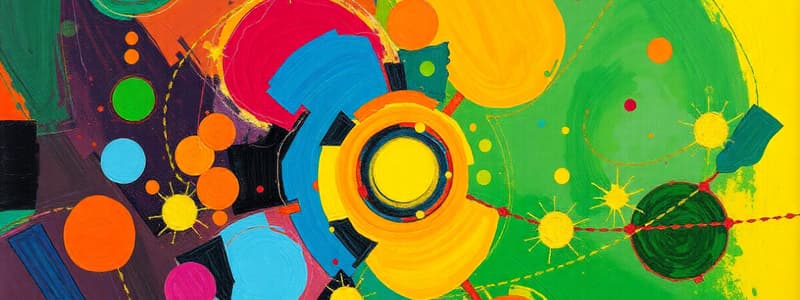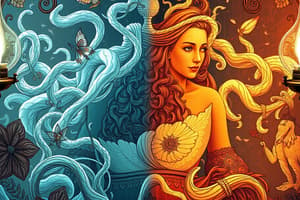Podcast
Questions and Answers
What type of bond involves the sharing of electron pairs between atoms?
What type of bond involves the sharing of electron pairs between atoms?
- Covalent bond (correct)
- Ionic bond
- Metallic bond
- Hydrogen bond
Lipids are classified as organic compounds that include fats and oils.
Lipids are classified as organic compounds that include fats and oils.
True (A)
What is the primary component of water?
What is the primary component of water?
H2O
The type of mixture that has a uniform composition throughout is called a ______.
The type of mixture that has a uniform composition throughout is called a ______.
Match the following types of compounds with their descriptions:
Match the following types of compounds with their descriptions:
What is the primary function of ribosomes in eukaryotic cells?
What is the primary function of ribosomes in eukaryotic cells?
The cell membrane is involved in active transport.
The cell membrane is involved in active transport.
What hypothesis explains the origin of mitochondria and chloroplasts in eukaryotic cells?
What hypothesis explains the origin of mitochondria and chloroplasts in eukaryotic cells?
The process of _____ uses light energy to convert carbon dioxide and water into glucose and oxygen.
The process of _____ uses light energy to convert carbon dioxide and water into glucose and oxygen.
Match the cellular processes with their respective energy requirements:
Match the cellular processes with their respective energy requirements:
Which of the following organelles is responsible for packaging and transporting proteins?
Which of the following organelles is responsible for packaging and transporting proteins?
The Krebs cycle is the first step in cellular respiration.
The Krebs cycle is the first step in cellular respiration.
In which part of the chloroplast do the light reactions of photosynthesis take place?
In which part of the chloroplast do the light reactions of photosynthesis take place?
Flashcards
What are elements?
What are elements?
The basic building blocks of matter that cannot be broken down into simpler substances by ordinary chemical means.
What is a compound?
What is a compound?
A substance composed of two or more different elements chemically combined in a fixed ratio.
What is an atom?
What is an atom?
The smallest unit of an element that retains the chemical properties of that element. They consist of a nucleus containing protons and neutrons, surrounded by a cloud of electrons.
What is a covalent bond?
What is a covalent bond?
Signup and view all the flashcards
What is an ionic bond?
What is an ionic bond?
Signup and view all the flashcards
What is the Cell Membrane?
What is the Cell Membrane?
Signup and view all the flashcards
What is the Cell Wall?
What is the Cell Wall?
Signup and view all the flashcards
What is the Cytoplasm?
What is the Cytoplasm?
Signup and view all the flashcards
What is the Nucleus?
What is the Nucleus?
Signup and view all the flashcards
What are Ribosomes?
What are Ribosomes?
Signup and view all the flashcards
What is the Endoplasmic Reticulum?
What is the Endoplasmic Reticulum?
Signup and view all the flashcards
What is the Golgi Apparatus?
What is the Golgi Apparatus?
Signup and view all the flashcards
What are Vacuoles?
What are Vacuoles?
Signup and view all the flashcards
Study Notes
Chapter 3 - Nature of Matter
- Physical properties are characteristics that can be observed without changing the matter's identity (color, odor, shape, etc.)
- Chemical properties describe a substance's ability to change into another substance through a reaction (flammability, acidity, magnetic properties, color changes)
- Phases are the different states of matter (solid, liquid, gas, plasma) and are a physical property
- Solids have a definite shape and volume, with particles moving slowly
- Liquids have a definite volume but not shape; particles can slide past each other
- Gases have no definite shape or volume; particles move freely
- Plasmas are ionized gases with free-roaming positive and negative charges (e.g., sun, stars)
Chapter 3 - Composition of Matter
- Atoms are the basic unit of matter
- The nucleus, at the atom's center, accounts for almost 100% of its mass
- Protons (positive charge), neutrons (no charge), and electrons (negative charge) are subatomic particles within the atom.
- An atom's atomic number is determined by the number of protons
- Mass number is the sum of protons and neutrons
- Ions are formed when atoms gain or lose electrons
- Cations are positively charged (loss of electrons), and anions are negatively charged (gain of electrons)
Chapter 3 - Atomic and Mass Number
- Atomic number identifies an atom and equals the number of protons in its nucleus
- Atoms of the same substance have the same atomic number
- Ions form when atoms lose or gain electrons
- Mass number is the sum of the total number of protons and neutrons in an atom's nucleus
Chapter 3 - Chemical Elements
- An element consists entirely of one type of atom
- Scientists have identified 109 elements
- 90 are found in nature; 19 are artificially produced
- Elements are represented by symbols
- Isotopes are atoms of the same element with the same number of protons but different numbers of neutrons; some are unstable and undergo radioactive decay
Chapter 4 - Water
- Water is a unique substance due to its physical and chemical properties
- Different temperatures affect water's density, and it expands when it freezes, which gives it unique characteristics in its liquid form
- Water molecules have uneven electron distribution which creates polar covalent bond properties as a physical property
- Water is a universal solvent and an important part of forming mixtures
Chapter 4 - Mixtures
- A mixture occurs when two or more elements or compounds are combined without chemical changes, that can physically be separated
- Homogeneous mixtures (e.g., solutions) are uniform throughout, with one substance dissolved in another
- Water's polarity makes it a great solvent
- Heterogeneous mixtures (e.g., suspensions) have uneven distributions of particles (needs to be shaken) and are visible
Chapter 4 - Acids and Bases
- Acids release hydrogen ions (H+) into solutions
- Bases release hydroxide ions (OH-) into solutions
- The pH scale measures the amount of hydrogen and hydroxide ions; it helps determine if substances are acidic, alkaline, or neutral
Chapter 4 - Chemical Compounds in Living Things
- The main elements found in living things are C, N, O, and H.
- 96.3% of the total weight of the human body makeup comprises these 4 elements varying in combination
Chapter 5 - Eukaryotic Cell Structures
- All eukaryotic cells have a cell membrane, cytoplasm, and a nucleus
- Cell Membrane: separates and controls what enters and exits the cell; is selectively permeable (acts like a filter, to allow certain things in and out)
- Cytoplasm: the liquid between the membrane and the nucleus, and contains organelles
- Nucleus: the control center, contains DNA and makes proteins
Chapter 5 - Cytoplasmic Organelles
- Mitochondria converts food into usable energy (ATP) in respiration
- Chloroplasts perform photosynthesis in plants, converting light energy into chemical energy
- Ribosomes construct proteins in the cell
- Endoplasmic reticulum modifies, transports, and stores proteins; Rough ER has ribosomes, Smooth ER doesn't
- Golgi Apparatus packages and sends molecules
- Vacuoles: stores materials, important for structure in plants
- Lysosomes digest cellular materials that are no longer needed
Chapter 5 - Cell Wall
- The cell wall is a rigid covering found in plant cells.
- It supports and protects the cell
- It has pores to allow substances to pass through the cell wall
Chapter 5 - Cytoskeleton
- The cytoskeleton is composed of filaments that support the cell
- It also aids in movement
Chapter 5 - Centrioles
- The centrioles assist in cell division
- They are found in animal cells, not plant cells
Chapter 6 - Photosynthesis
- Photosynthesis converts light energy from the sun into chemical energy in the form of carbohydrates (sugar).
- The process requires water, carbon dioxide, and light.
- The process releases oxygen.
- Chlorophyll absorbs light energy, and this powers the reactions.
Chapter 6 - Pigments
- Pigments are substances in plants that absorb light
- Chlorophyll A and B are the main pigments in plants, absorbing blue and red light and reflecting green light
- Carotenoids absorb other colors, extending the range of photosynthetic wavelengths
- Chloroplasts are organelles that contain thylakoids.
Chapter 6 - Energy Storing
- Energy is stored in ATP and NADPH
- ATP is a form of energy that is released through breaking down the phosphate bonds
Chapter 6 - Light Reactions
- Light reactions capture light energy in Chlorophyll and turn it into chemical energy
- ATP and NADPH are used in the Calvin Cycle
Chapter 6 - Cellular Respiration
- Cellular respiration breaks down glucose (carbohydrates) to release stored energy,
- Process is aerobic because it needs oxygen
- Most energy is made in the final stage, the Electron Transport Chain (ETC)
Chapter 6 - Aerobic Respiration
- It involves oxygen and breaks down food molecules to release energy
- The Krebs cycle is part of aerobic respiration, breaking down pyruvic acid, releasing energy in the form of ATP
Chapter 6 - The Electron Transport Chain (ETC)
- The ETC is where the maximum amount of ATP is created during cellular respiration
Chapter 6 - Fermentation
- Fermentation occurs in the absence of oxygen
- It creates NAD+ so that glycolysis can continue
- There are two types: alcoholic and lactic acid fermentation
Studying That Suits You
Use AI to generate personalized quizzes and flashcards to suit your learning preferences.




